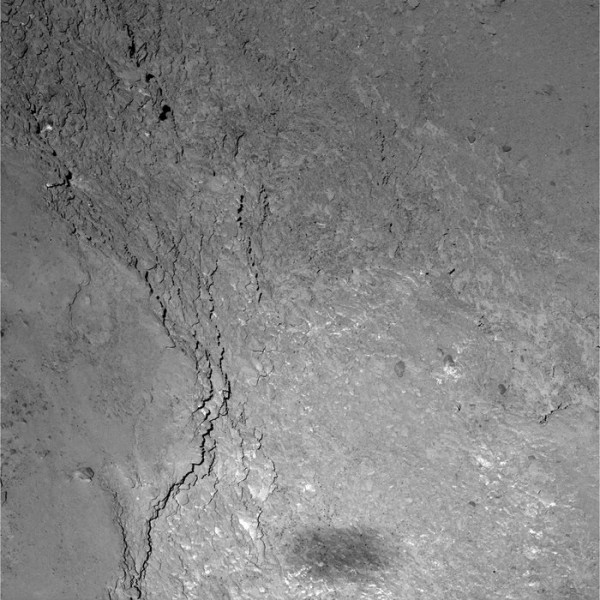Rosetta Captures "Selfie" of its Shadow on Comet 67P
| Ana Verayo | | Mar 04, 2015 06:32 AM EST |
(Photo : ESA/Rosetta/MPS for OSIRIS Team MPS/UPD/LAM/IAA/SSO/INTA/UPM/DASP/IDA) Rosetta's shadow is shown in this view of Comet 67P/Churyumov-Gerasimenko as seen by the OSIRIS narrow-angle camera.
The European Space Agency's Rosetta probe took a "selfie" of its shadow cast upon the surface of Comet 67P Churyumov-Gerasimenko. This unique moment took place when the spacecraft was directly in front of the Sun as it orbited this icy body.
The photograph was taken by Rosetta's Optical, Spectroscopic and Infrared Remote Imaging System (Osiris) and was released last February 14. The image of the spacecraft and its shadow on Comet 67P was captured when the probe was just 3.6 miles above the surface.
Like Us on Facebook
The low altitude made it possible to acquire a resolution of four inches for every pixel. After three days, the orbiter travelled 159 miles away from the comet. The surface of the comet was again observed at a distance of 69 miles away on February 28.
This image with this different light source reveals significant differences and brightness in the comet's surface, according to Ekkehard Kührt of the German Aerospace Center. Apparently, there are no shadows in the photo and this was probably caused by the scattering of light by dust particles across the comet's surface.
Researchers study these differences to further examine the light and dark regions of the comet. With this photo, it's also possible to determine the size of the particles even if they're too tiny to be resolved by the camera.
The fissure on the surface can be seen directly below the spacecraft. This view or alignment makes it impossible to predict or measure how far the crack on the surface of the comet extends or how deep it is.
Astronomers are now calling this crack or fissure on comet 67P "Imhotep", after the first famous architect and engineer in Egyptian history. The Philae lander that made its hard and rocky touchdown on the comet last November is still on the other side of the icy body.
Most images taken by the Philae lander of the surface reveals a resolution of 25 pixels per inch. Researchers still hope to recover the now hibernating lander since Philae's images and data can reveal more secrets about the comet's icy nucleus and composition and how planets and other bodies in the solar system were formed.
ESA will release its findings from the high-detail images they have obtained by April.
The Rosetta spacecraft was launched almost more than a decade ago and became the first probe to orbit a comet. During its epic deep space voyage, Rosetta visited Mars and two other asteroids. It finally rendezvoused with the comet in August 2014.
TagsRosetta Captures "Selfie" of its Shadow on Comet 67P, ESA, rosetta spacecraft, rosetta probe, rosetta selfie comet, comet 67P, rosetta shadow selfie comet
©2015 Chinatopix All rights reserved. Do not reproduce without permission
EDITOR'S PICKS
-

Did the Trump administration just announce plans for a trade war with ‘hostile’ China and Russia?
-

US Senate passes Taiwan travel bill slammed by China
-

As Yan Sihong’s family grieves, here are other Chinese students who went missing abroad. Some have never been found
-

Beijing blasts Western critics who ‘smear China’ with the term sharp power
-

China Envoy Seeks to Defuse Tensions With U.S. as a Trade War Brews
-

Singapore's Deputy PM Provides Bitcoin Vote of Confidence Amid China's Blanket Bans
-

China warns investors over risks in overseas virtual currency trading
-

Chinese government most trustworthy: survey
-

Kashima Antlers On Course For Back-To-Back Titles
MOST POPULAR
LATEST NEWS
Zhou Yongkang: China's Former Security Chief Sentenced to Life in Prison

China's former Chief of the Ministry of Public Security, Zhou Yongkang, has been given a life sentence after he was found guilty of abusing his office, bribery and deliberately ... Full Article
TRENDING STORY

China Pork Prices Expected to Stabilize As The Supplies Recover

Elephone P9000 Smartphone is now on Sale on Amazon India

There's a Big Chance Cliffhangers Won't Still Be Resolved When Grey's Anatomy Season 13 Returns

Supreme Court Ruled on Samsung vs Apple Dispute for Patent Infringement

Microsoft Surface Pro 5 Rumors and Release Date: What is the Latest?










